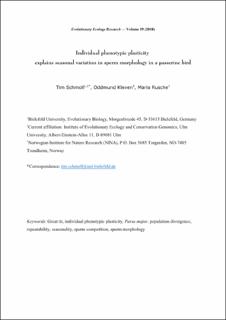Individual phenotypic plasticityexplains seasonal variation in sperm morphology in a passerine bird
Peer reviewed, Journal article
Published version

Åpne
Permanent lenke
https://hdl.handle.net/11250/3060118Utgivelsesdato
2018Metadata
Vis full innførselSamlinger
- Publikasjoner fra CRIStin - NINA [2364]
- Scientific publications [1392]
Originalversjon
Evolutionary Ecology Research. 2018, 19 .Sammendrag
Background: Spermatozoa display impressive variation in size and form among and within animal species. In birds, comparative evidence suggests that post-copulatory sexual selection resulting from extra-pair copulations is a major driver of interspecific sperm trait variation. However little is known about the extent, determinants and dynamics of intraspecific variation in avian sperm traits. Goal: Characterize and analyze variation in sperm morphology within and among two natural populations of great tits (Parus major) — a socially monogamous passerine with frequent extra-pair matings. Methods: We studied both a German and a Norwegian population of P. major. In the German population we sampled spermatozoa during both the first clutch egg-laying and the nestling period (partly from the same individual males). In the Norwegian population we sampled spermatozoa during the pre-laying/egg-laying period. We measured the length of spermatozoa with separate measurements of sperm head, midpiece and tail length. Results: In the German population, spermatozoa were significantly shorter during the nestling period than during the egg-laying period. Individual phenotypic plasticity was responsible for the seasonal dynamics in sperm morphology. Changes in flagellum length (sum of midpiece and tail length) rather than changes in head length accounted for the change observed in total length. We found that changes in flagellum length were attributable to both midpiece and, in particular, tail shortening. Consequently the ratio, 'midpiece/total length,' increased over the breeding cycle. Controlling statistically for seasonal variation, sperm total length was significantly repeatable across sperm samples from the same males. Furthermore, spermatozoa sampled in a Norwegian population early in the season differed from those obtained from the German population during egg-laying, but not from those obtained from the German population during the nestling period. Conclusions: Individual phenotypic plasticity across the breeding season may contribute to intraspecific variation in avian sperm morphology. Our comparison across populations illustrates that seasonal variation in sperm dimensions within populations may confound between-population comparisons unless one controls for sampling date in relation to reproductive phenology.Great tit, individual phenotypic plasticity, Parus major, population divergence, repeatability, seasonality, sperm competition, sperm morphology